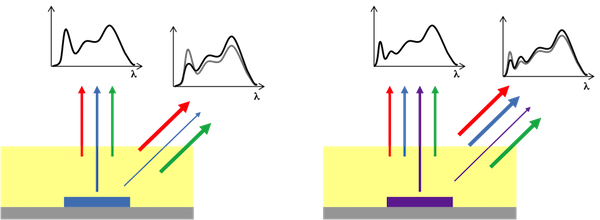When discussing the properties of LEDs, the word ‘color’ immediately comes to our minds; and there are so many facets to our perception of color! An important one is color consistency, which is really a blanket qualifier for a variety of phenomena. Today, I will discuss color consistency at the level of the LED component (i.e. the white emitter including an LED die and phosphors). Keep in mind, though, that this is only part of the story, and eventually the system-level behavior is what matters.
In a perfect world, we would like our LEDs to always produce good colors—for every part, under any conditions, and forever! Reality, of course, has it differently.
Part-to-part variations are probably the best-known aspect of color consistency. When manufacturing a white LED, various factors contribute to variability in the emitted spectrum. First, the pump LEDs themselves tend to have a peak wavelength distribution, caused by variability in the complex epitaxial process used to grow LED wafers. The industry devotes substantial efforts to reducing these variations, but at the same time the push towards ever-larger epitaxial wafers makes this endeavor a moving target. Second, the phosphor layer around the pump LEDs has to be carefully controlled (within a few percent) so that the right amount of pump light is converted. As a result of these and other factors, LEDs of a nominal CCT have a chromaticity distribution that spreads across color space. In practice, this leads to differences in the “white tint” of nominally-identical LEDs. This spread is often expressed in MacAdam (MC) ellipses, with a one-unit MC ellipse corresponding to a just-noticeable difference between two parts. Today, most manufacturers have distribution spreading across three to five MC ellipses—although we can expect a push towards tighter distributions in the future.
However, this is only part of the discussion. Unfortunately, color often varies within a given LED part, most significantly as a function of the angle of emitted light. This color-over-angle (CoA) effect is not trivial: it can lead to “yellow rings” at large angles in the far-field of a white LED. CoA can be explained by simple geometric considerations (see figure): in many LED architectures, the blue pump light has to leak through a partially-absorbing phosphor to contribute to the white spectrum; at large angles, the optical path of blue light is larger, leading to more absorption and a spectrum with less blue light and more phosphor-converted light. The impact of CoA should not be underestimated, as our subjective assessment can be surprisingly sensitive to slight angular variations in chromaticity (a topic worthy of a separate discussion!). CoA is seldom specified for LED components; but looking at industry spreadsheets, it is not uncommon to run into CoA variations as large as five to ten MC ellipses! Of course, CoA can be mitigated with optics at the system level, at the cost of extra complexity. Overall however, this makes one wonder about our expectations for color consistency: is it reasonable to seek a part-to-part variation of one MC, but accept a within-part variation that is an order of magnitude larger?
 |
(Left) Color-over-angle in a standard blue-pumped LED. At normal incidence, a fraction of the blue pump light leaks out to produce a balanced white spectrum. At large angles, more blue light is absorbed, resulting in an off-color spectrum with less blue and more green/red than wanted.(Right) In Soraa’s VP3 LEDs, two effects counterbalance each other at large angle: the increase in violet light absorption and in blue light emission; thus mitigating CoA effects. (Soraa/LEDinside)
|
Finally, operating conditions have an impact on the color consistency. For instance, many phosphors are temperature-sensitive, which can lead to a shift in chromaticity point as the power—and hence the temperature—of the LED increases. This problem is further compounded in systems mixing different kinds of LEDs (for instance, blue and red) where the significant difference in temperature sensitivity requires active management of the power fed into the different LEDs. Likewise, uneven degradation of the parts of an LED over time can lead to drifts in color consistency with ageing.
Interestingly, Soraa’s VP3 approach, combining violet pump LEDs with three phosphors instead of two to produce a white spectrum, is advantageous for various aspects of color consistency. The key reason is that the white balance at short wavelength is achieved by a combination of violet and blue light. Thus overall, the emitted spectrum is more robust to the amount of phosphor (because more violet absorption produces more blue, mitigating the large sensitivity found in conventional approaches). More importantly, CoA is naturally improved—indeed, the longer geometric path of violet light at large angles does lead to more phosphor absorption, but the resulting emission of blue light compensates this to yield a stable color cross angles.
Overall, the color consistency discussion remains complicated enough to confuse all but the most sophisticated users. Today, no standards govern color consistency at the component level; this is in part because the overall system-level is what matters at the end of the day, but of course the two aspects are heavily coupled. One can only hope that steady technology improvements by the industry will lead to such high-quality components that the issue eventually subsides!












